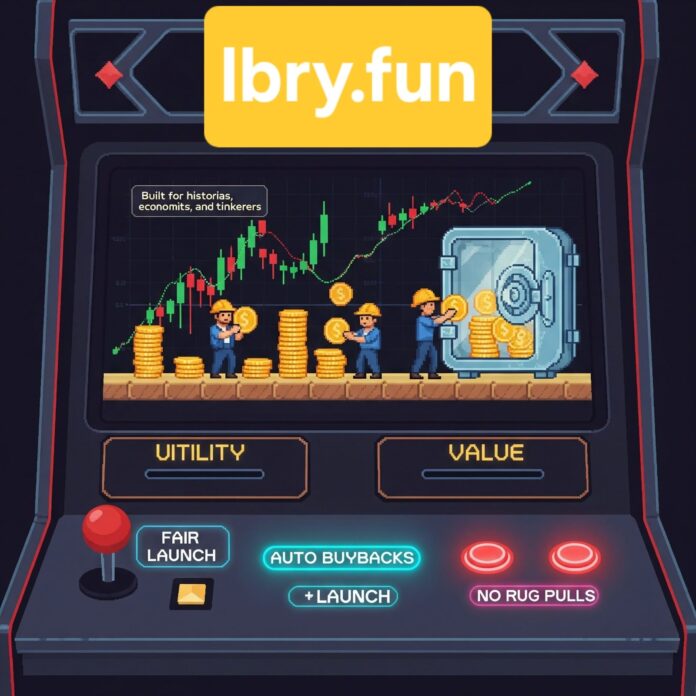The team behind Alexandria, the forever-library on the Internet Computer, has stepped forward with a new product—lbry⋅fun. It’s a launchpad that’s part tech, part philosophy, and all about making crypto launches more grounded, less flashy, and harder to exploit. Where most platforms lean into hype and fast unlocks, lbry⋅fun aims to be the place for slow-cooked launches, real revenue sharing, and token models that don’t fall apart once the first green candle fades.
At the centre of it is a dual-token structure. Each project launching through lbry⋅fun will get two tokens: one pegged to stability and function, and the other designed for value capture and community governance. The idea is to keep the core product clean—no confusing mix of speculative and functional use cases—while still offering something meaningful to early believers. Users interact with the stable side to access the product; they stake the value token to earn revenue and participate in decision-making.
The second big shift comes with emissions. Instead of frontloading tokens into the market and watching them collapse under their own weight, lbry⋅fun mints them as the project grows. This ties token supply directly to delivery. The more a product is used, the more its tokens come into circulation. If the team disappears, the token does nothing. If they keep building, so does the supply. It’s a neat inversion of the usual model, where investors often carry all the early risk.
Revenue-sharing mechanics are similarly enforced. Value tokens on lbry⋅fun are stakable from the beginning, and staking returns are paid in ICP. These aren’t theoretical rewards; they’re real proceeds from the project’s usage, delivered on-chain through an automated contract. The structure is tamper-proof—teams can’t reroute the funds or rewrite the rules. And since the yield grows as the product gains traction, there’s a natural feedback loop that supports long-term holding.
There’s also a forced buyback built into the protocol. A quarter of all staking rewards are earmarked to automatically repurchase the project’s own value token. It’s not a community vote. It’s not a nice-to-have. It’s just how the system works. With regular buy pressure driven by actual growth, token value is linked to performance rather than to sentiment.
Another quarter of staking rewards is locked into a liquidity pool on ICPSwap. Those tokens aren’t just added—they’re locked forever. This removes the risk of teams pulling liquidity and leaves behind a pool that grows alongside the project. For users used to the whiplash of sudden exits, this provides something rare in crypto: assurance that liquidity won’t suddenly vanish.
The application process for lbry⋅fun is deliberately hands-on. Launching a project takes work and a small upfront fee. The barrier isn’t just there to slow people down—it’s a filter. By requiring genuine effort and a bit of skin in the game, the team wants to ensure that what launches is worth engaging with. They’re betting that builders willing to go through the process are more likely to stick around.
Transparency is hardcoded throughout the launch process. No stealth launches. Every project gets a 24-hour announcement window before anything goes live. Emissions aren’t hidden either—they roll out slowly and visibly, with a dashboard showing every movement. It’s a play for accountability in a space where sudden token drops and fleeting launch windows are all too common.
The model isn’t just protective; it’s interactive. lbry⋅fun adds layers of gamification to each launch. The way emissions are structured, how liquidity behaves, the size and timing of buybacks—all these can be adjusted by the creators, forming what the team describes as economic mini-games. The community doesn’t just invest; it plays, analyses, and adapts in real time.
This experimentation isn’t random. It’s part of the platform’s ethos. Rather than force every project into a fixed mould, lbry⋅fun treats each launch as its own simulation. The hope is to create a library of economic behaviours that future builders can learn from. Alexandria, after all, is still at the heart of the project. The archive mindset remains: to record, preserve, and iterate.
Fees on lbry⋅fun are intentionally simple. The platform takes a flat 1%, all of which flows to $ALEX stakers. There are no extra charges, backroom deals, or sliding scales based on how much a project raises. The business model is baked in, not tacked on. It’s straightforward and public.
As for the team’s broader ambition, it’s refreshingly modest. They’re not trying to turn lbry⋅fun into a mainstream launchpad or chase mass market attention. They’re building for a specific type of creator—someone interested in long-term value, hard constraints, and clean on-chain economics. The kinds of people who want to launch projects for historians and economists, not just for speculators.
The backdrop, of course, is the Internet Computer. All of this is happening natively on the IC, and the reasons for choosing it are clear. The platform allows for end-to-end on-chain architecture without relying on bridges, third-party servers, or patchwork integrations. That consistency is critical when so much of lbry⋅fun’s trust model depends on automation and visibility.
There’s no push for loud endorsements or influencer hype. Instead, the emphasis is on trust, fairness, and repeatability. Launches aren’t meant to be momentary fireworks; they’re structured, gradual events with feedback loops that reward patience and participation.
For a crypto space often obsessed with what’s next, lbry⋅fun is a call to think about what lasts. It’s a structure for people who want to launch projects that can still function in five years—without needing rescue pumps or narrative pivots. The incentives are aligned, the rules are clear, and the floor is open to anyone willing to play by them.
Whether the wider market adopts the model or not, lbry⋅fun is putting forward a workable case for a better launchpad. One where fairness isn’t just a tagline, where liquidity isn’t at risk of vanishing, and where builders can set clear, enforceable rules from day one.
The crypto world has seen too many launches that collapsed under their own complexity or carelessness. This one’s betting on structure, sustainability, and a lot less noise.
Dear Reader,
Ledger Life is an independent platform dedicated to covering the Internet Computer (ICP) ecosystem and beyond. We focus on real stories, builder updates, project launches, and the quiet innovations that often get missed.
We’re not backed by sponsors. We rely on readers like you.
If you find value in what we publish—whether it’s deep dives into dApps, explainers on decentralised tech, or just keeping track of what’s moving in Web3—please consider making a donation. It helps us cover costs, stay consistent, and remain truly independent.
Your support goes a long way.
🧠 ICP Principal: ins6i-d53ug-zxmgh-qvum3-r3pvl-ufcvu-bdyon-ovzdy-d26k3-lgq2v-3qe
🧾 ICP Address: f8deb966878f8b83204b251d5d799e0345ea72b8e62e8cf9da8d8830e1b3b05f
🪙 BTC Wallet: bc1pp5kuez9r2atdmrp4jmu6fxersny4uhnaxyrxau4dg7365je8sy2q9zff6p
Every contribution helps keep the lights on, the stories flowing, and the crypto clutter out.
Thank you for reading, sharing, and being part of this experiment in decentralised media.
—Team Ledger Life


